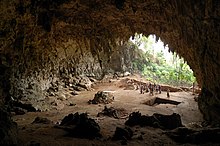Liang Bua
Liang Bua ( "cool cave") is the name of a limestone - cave on the Indonesian island of Flores , the first in the 2003 fossils of Homo floresiensis were discovered.
Texture of the cave
The cave is located 14 kilometers north of Ruteng and 25 kilometers from the north coast of the island, at around 500 meters above sea level, on a slope around 30 meters above the Wae Racang River . It is approximately 30 meters wide, 25 meters high and up to 40 meters deep. The cave was formed underground around 600,000 years ago as a washout in a karst formation from the Miocene . Its northern end was only eroded around 190,000 years ago by what was once the higher course of the river, whereupon up to eleven meters thick layers of material from the field were brought in over the course of thousands of years. At the bottom are conglomerates of round cut stones, which prove that they are deposits of the river. The overlying sediments consist partly of clay , but partly also of sinter and volcanic ash , which can be used to date fossils.
Excavation findings
The first excavations in the Liang Bua Cave were carried out in 1965 by the Catholic priest and ancient historian Theodor Verhoeven . Verhoeven had already got to know the cave in 1950 when it was still used as a primary school. "When he began excavations in 1965, he found recent human graves and fossils of the rat Paulamys , which is endemic to Flores ," and a collection of stone tools; however, his discoveries in this cave were not published. Further excavations did not take place until 1978, 1981, 1982, 1985, 1987 and 1989 under the direction of the Indonesian archaeologist RP Soejono, to whom Verhoeven had reported in a 1973 letter of his excavations. Soejeno's excavations uncovered further Neolithic graves and reached a maximum depth of 4.20 meters, which corresponds to an age of the layer of 10,000 years BP.
In 2001, research into the cave was resumed by an Australian-Indonesian team led by Mike Morwood ( University of New England ) and Thomas Sutikna (Indonesian Center for Archeology, Jakarta ). The aim of these new excavations was to secure evidence of an early settlement of the island of Flores by representatives of the genus Homo (probably Homo erectus ), whose existence on the island is documented by stone tools up to 840,000 years old .
In addition to Homo floresiensis , numerous remains of an unusually small stegodon ( Stegodon florensis insularis ) and Komodo dragons were found in the Liang Bua Cave , which is attributed to the effects of Homo floresiensis . From different horizons , the oldest of which is at least 95,000 years old, numerous stone tools came to light that - together with 7000 to 3000 year old bones of farm animals and other, more recently dated finds - point to a settlement history up to the 20th century.
There was also evidence of several fireplaces, the age of which was dated between 41,000 and 24,000 years ago.
literature
- Mike J. Morwood and William L. Jungers (Eds.): Paleoanthropological Research at Liang Bua, Flores, Indonesia. In: Journal of Human Evolution. Volume 57, No. 5, 2009, pp. 437-648, table of contents
- Mike J. Morwood et al .: Archeology and age of a new hominin from Flores in eastern Indonesia. In: Nature . Volume 431, 2004, pp. 1087-1091, doi: 10.1038 / nature02956
- Knepper, Gert M. (2019): Floresmens - Het leven van Theo Verhoeven, missionaris en archeoloog . ISBN 978-94-6389-247-6 . (Boekscout, Soest, Netherlands) (= Verhoeven's biography, in Dutch)
Individual evidence
- ↑ Kira Westaway et al .: The evolving landscape and climate of western Flores: an environmental context for the archaeological site of Liang Bua. In: Journal of Human Evolution. Volume 57, No. 5, 2009, pp. 450-464, doi: 10.1016 / j.jhevol.2009.01.007
- ↑ Gary J. Sawyer, Viktor Deak: The Long Way to Man. Life pictures from 7 million years of evolution. Spektrum Akademischer Verlag, Heidelberg 2008, p. 136
- ^ A b c Mike Morwood et al .: Preface: research at Liang Bua, Flores, Indonesia. In: Journal of Human Evolution. Volume 57, No. 5, 2009, pp. 437-449, doi: 10.1016 / j.jhevol.2009.07.003
-
↑ Mike J. Morwood et al .: Archaeological and palaeontological research in central Flores, east Indonesia: results of fieldwork 1997-98. In: Antiquity. Volume 73, No. 280, 1999, pp. 273-286, doi: 10.1017 / S0003598X00088244
Mike J. Morwood et al .: Fission-track ages of stone tools and fossils on the east Indonesian island of Flores. In: Nature . Volume 392, 1997, pp. 173-176, doi: 10.1038 / 32401 - ^ Gert D. van den Bergh et al .: The youngest Stegodon remains in Southeast Asia from the Late Pleistocene archaeological site Liang Bua, Flores, Indonesia. In: Quaternary international. Volume 182, 2008, pp. 16-48, ISSN 1040-6182 , abstract
- ↑ Gert D. van den Bergh et al .: The Liang Bua faunal remains: a 95 k.yr. sequence from Flores, East Indonesia. In: Journal of Human Evolution. Volume 57, No. 5, 2009, pp. 527-537, doi: 10.1016 / j.jhevol.2008.08.015
-
↑ Mike W. Morley et al .: Initial micromorphological results from Liang Bua, Flores (Indonesia): Site formation processes and hominin activities at the type locality of Homo floresiensis. In: Journal of Archaeological Science. Online advance publication of June 29, 2016, doi: 10.1016 / j.jas.2016.06.004
Fire discovery sheds new light on 'hobbit' demise. On: eurekalert.org of June 29, 2016
Coordinates: 8 ° 32 ′ 3 ″ S , 120 ° 27 ′ 37 ″ O
